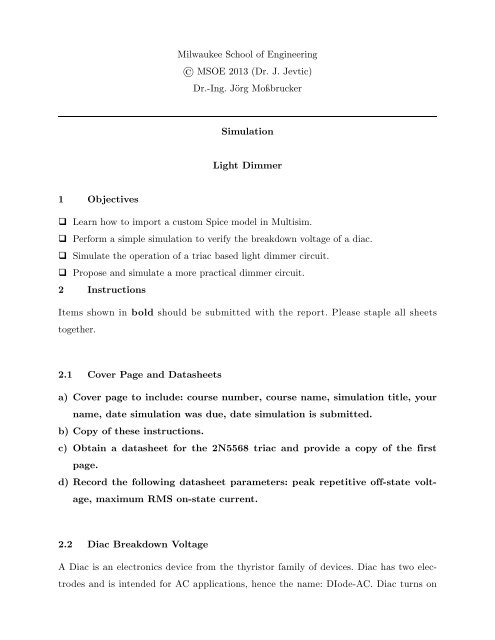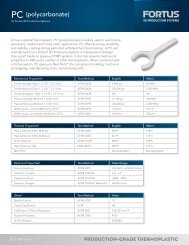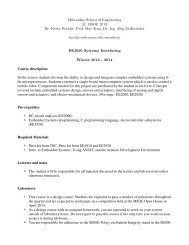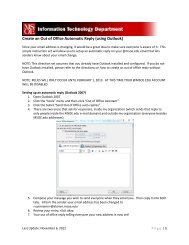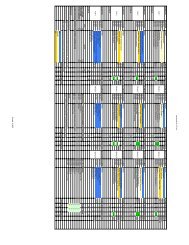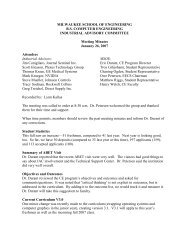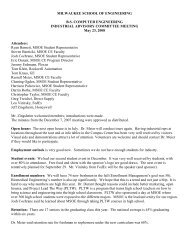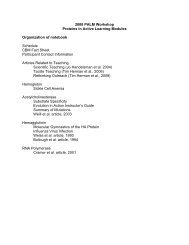Simulation Homework 2, due Friday week 4 - Milwaukee School of ...
Simulation Homework 2, due Friday week 4 - Milwaukee School of ...
Simulation Homework 2, due Friday week 4 - Milwaukee School of ...
You also want an ePaper? Increase the reach of your titles
YUMPU automatically turns print PDFs into web optimized ePapers that Google loves.
<strong>Milwaukee</strong> <strong>School</strong> <strong>of</strong> Engineering© MSOE 2013 (Dr. J. Jevtic)Dr.-Ing. Jörg Moßbrucker<strong>Simulation</strong>Light Dimmer1 Objectives Learn how to import a custom Spice model in Multisim. Perform a simple simulation to verify the breakdown voltage <strong>of</strong> a diac. Simulate the operation <strong>of</strong> a triac based light dimmer circuit. Propose and simulate a more practical dimmer circuit.2 InstructionsItems shown in bold should be submitted with the report. Please staple all sheetstogether.2.1 Cover Page and Datasheetsa) Cover page to include: course number, course name, simulation title, yourname, date simulation was <strong>due</strong>, date simulation is submitted.b) Copy <strong>of</strong> these instructions.c) Obtain a datasheet for the 2N5568 triac and provide a copy <strong>of</strong> the firstpage.d) Record the following datasheet parameters: peak repetitive <strong>of</strong>f-state voltage,maximum RMS on-state current.2.2 Diac Breakdown VoltageA Diac is an electronics device from the thyristor family <strong>of</strong> devices. Diac has two electrodesand is intended for AC applications, hence the name: DIode-AC. Diac turns on
2when the voltage <strong>of</strong> either polarity between the terminals exceeds the breakdown voltagefor which the diac was designed. Diac turns <strong>of</strong>f when the current falls below the holdingcurrent level, or practically, when the current tries to reverse direction.In this simulation, we will build a simple diac test circuit shown in Fig. 2.1 in order toverify the diac breakdown voltage. Diacs have poorly controlled breakdown voltage sothat a nominal 24V device may actually have a breakdown voltage anywhere between20V and 28V. The AC source applies a voltage from – V rms2 to V rms2 , while theresistor R1 limits the current when the diode turns on. By observing the voltage directlyacross the diac we can determine the breakdown voltage.FIGURE 2.1 :TEST CIRCUIT FOR DIAC BREAKDOWN VOLTAGE.a) Build the circuit in Multisim and use Simulated Agillent Oscilloscope tomeasure AC source voltage on Channel 1 and diac voltage on Channel 2,as shown in Fig. 2.1. Diac 1N5759 can be found in Master Database->Diodes ->Diacs.b) Use the switch in the upper left corner to start the simulation. Use Quick Measurementbutton on the scope to find the maximum value <strong>of</strong> the voltage across the diac.c) Provide a printout <strong>of</strong> the scope display showing both waveforms and themaximum diac voltage measurement.d) What is the value <strong>of</strong> the diac's breakdown voltage?
32.3 Importing Spice ModelManufacturers frequently provide Spice models for their electronic devices. Importing acustom device model in Multisim is simple. Follow the instructions below to import acustom model for 2N5568 triac. Since Multisim already comes with a model for thisdevice, we will call our model 2N5568_1 and place it in the User Database.a) Open a new Schematic Capture and select Tools->Component Wizardb) See Fig. 2.2FIGURE 2.2 :FIG. 2 STEP 1 OF THE COMPONENT WIZARD.c) Change the number <strong>of</strong> electrodes to 3 (two main electrodes and the gate.)d) Select "Copy from DB" and select any <strong>of</strong> the triacs from the Master Database (underMaster Database->Diodes->Triacs.) This will only copy the schematic symbol.e) Click next.
4f) Name the actual model 2N5568_1 and paste the content <strong>of</strong> the provided"2N5568.txt" file in the Model Data field as shown in Fig. 2.3. Make sure you edit theoriginal .SUBCKT statement: change 2N5568 to 2N5568_1.FIGURE 2.3 :FIG. 3 STEP F OF THE COMPONENT WIZARDg) Note the terminal assignments in the first two lines <strong>of</strong> the device model in Fig. 2.3:pin 1 is MT2 (main terminal 2), pin 2 is G (gate), and 3 is MT1 (main terminal 1.)Modify pin numbers in this Step accordingly.
5h) Save the new model in the User Database. This completes the import <strong>of</strong> a customdevice model. To verify that the component is properly installed, place the new2N5568_1 component on the schematic (it should be available in the User Database,)double-click on the component, select the Value tab, and click on Edit Model button.i) Provide a printout <strong>of</strong> the schematic window showing the new 2N5568_1component and its Edit Model window.2.4 Light Dimmer: Floating LoadThe light dimmer circuit shown in Fig. 2.4, uses the mains AC voltage directly as a referencevoltage for the RC phase-shifter which generates the gate triggering signal.FIGURE 2.4 :LIGHT DIMMER CIRCUIT WITH A FLOATING LOAD.In the circuit shown in Fig. 2.4, R and C form an adjustable phase shift circuit for controllingthe firing angle <strong>of</strong> the triac. Component R is a potentiometer (available in MasterDatabase->Basic.) The position <strong>of</strong> the wiper can be controlled interactively during the
6simulation by pressing a keyboard key which can be defined by double-clicking the componentand selecting the Value tab. In Fig. 2.4, pressing "A" would cause the resistanceto increase, and pressing "Shift-A" would cause the resistance to decrease.During each half-cycle <strong>of</strong> the power supply voltage, the diac and traic are initially <strong>of</strong>f andthe capacitor C charges through the resistor R. Once the voltage across the capacitorexceeds the breakdown voltage <strong>of</strong> the diac, the diac turns on and discharges the capacitorthrough gate <strong>of</strong> the triac. Gate resistor Rg limits the gate current. At the beginning <strong>of</strong>the next half-cycle, the load current reverses direction and the triac turns <strong>of</strong>f, thusrepeating the process.The shunt resistor Rs serves to convert the load current to voltage that can be measureddirectly on the scope. Since the load is purely resistive, such as an incandescent light bulbor a heater, we can also directly deduce the voltage across the load.a) If the voltage across the load is 1V, what will be the voltage drop acrossthe shunt resistor? Use the values <strong>of</strong> shunt and load resistances shown inFig. 2.4.b) Build the circuit shown in Fig. 2.4 in Multisim and provide a schematicsprintout.c) Start the simulation and adjust the scope display.d) Use the Cursor button on the scope to determine the minimum and maximumfiring delays in milliseconds as the resistance <strong>of</strong> the potentiometer ischanged from 0 to the maximum value. Show the printout <strong>of</strong> the scope displayfor the largest firing delay case.e) Calculate the minimum and maximum firing angles in degrees (using thetime delays measured in step d.)f) Use Quick Measurement button on the scope to measure the RMS values<strong>of</strong> source voltage (Channel 1) and shunt resistor voltage (Channel 2.) Providea printout <strong>of</strong> the scope screen for the largest firing angle case.g) What are the minimum and maximum RMS voltages across the load asthe resistance <strong>of</strong> the potentiometer changes from 0 to the maximum value?(Use the result <strong>of</strong> step a to convert shunt voltage to load voltage.)
7h) What is the range <strong>of</strong> load powers in Watts that can be controlled with thisdimmer?2α – sin2αi) Use the formula V rms( α) = V rms( 0) 1 – --------------------------- , where V rms (0)=120V,2πand α is the firing angle to calculate the theoretical RMS load voltage forthe minimum and maximum firing angles determined in step e.j) Compare theoretical results <strong>of</strong> step h to the values measured in step g.2.5 Light Dimmer: Grounded LoadTwo disadvantages <strong>of</strong> the light dimmer circuit shown in Fig. 2.4 are: none <strong>of</strong> the load terminals are grounded, and an existing electro-mechanical switch cannot be replaced by a dimmer without rewiringthe electrical installations.Your task is to come up with an alternative dimmer circuit for a grounded load that canbe simply substituted for an existing electro-mechanical switch. You should use exactlythe same components as in Fig. 2.4, but connected differently. You do not need the shuntresistor Rs because the voltage across a grounded load can be measured directly. Thereare several possibilities but not all will work. Use the Multisim simulation to confirm thatyour proposed circuit works (i.e., allows the RMS voltage across a grounded load to becontinuously adjusted by changing the resistance <strong>of</strong> the potentiometer.)a) Sketch a simple circuit consisting <strong>of</strong> a grounded AC source, a SPST switch, and agrounded resistive load.b) Design a dimmer circuit to replace the SPST switch as explained above.c) Provide a printout <strong>of</strong> the schematics showing the entire proposed lightdimmer circuit with a grounded load.d) Provide a printout <strong>of</strong> the scope display showing the source voltage andload voltage for the maximum firing angle case.e) Use the simulation to find the minimum and maximum RMS load voltagethat can be achieved with your proposed dimmer circuit.


